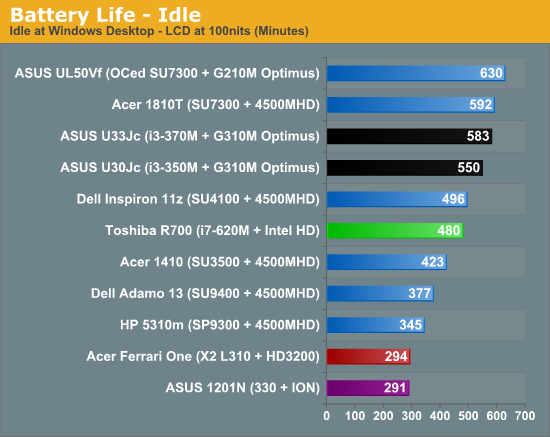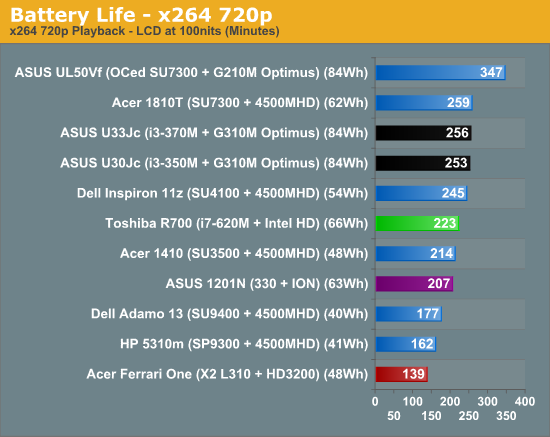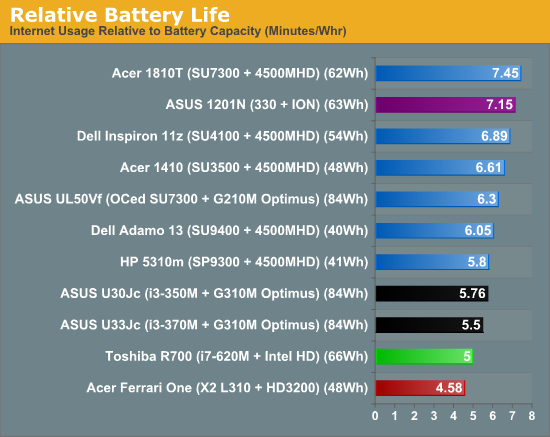Toshiba Portege R700: A Truly Ultraportable 13.3"
by Vivek Gowri on September 7, 2010 6:01 PM EST- Posted in
- Laptops
- SSDs
- Toshiba
- Portege R700
Toshiba Portege R700—Battery, Heat, Noise
So, now for the real test. The R700 has some pretty great specs, but with the powerful Core i7 processor, how does it acquit itself versus the rest of the thin and light class with regards to battery life?




Overall, pretty well. Toshiba claims 8 hours of runtime and we managed exactly that in our ideal battery usage scenario. In our more realistic internet browsing test, the R700 hit 5.5 hours, and just under 4 hours in our HD x264 playback test. So overall, given the specs, pretty solid. I’d expect the R705 to get better battery life in both the internet and x264 use cases, but not significantly more than 8 hours when completely idle. So where you’d get around 5.5-6 hours realtime usage out of the R700 test unit we have, the lower specced R700s and the R705 are probably closer to 6-6.5 hours of real world battery life.
Toshiba’s heat-dissipating aluminum honeycomb under the palmrest does it’s job quite well, and even during benchmarking and stress testing, the palmrests don’t get hot. However, the bottom of the computer gets pretty toasty, probably due to the powerful Core i7 processor being shoehorned into such a small enclosure. And when doing anything intensive, the fans definitely make themselves heard. It’s not particularly disturbing, but I will say that it’s kind of unnatural to hear the fans cranking at max speed but not feeling the heat at all in the top half of the chassis.










43 Comments
View All Comments
bertomatic - Tuesday, September 7, 2010 - link
While i agree I hate bloat/crap ware, and always do a "clean install".I'd like to see before and after results of all tests of this system, one "out-of-the-box" and one with a "clean install"
Thank you...
DigitalFreak - Tuesday, September 7, 2010 - link
I agree. Even if you don't run the full test suite, I'd love to see benchmarks from both out of the box and after a clean install. If all the big review sites would do this, maybe the manufacturers would get the hint when they see public benchmarks showing their system runs like crap with all the bloat-ware.yyrkoon - Tuesday, September 7, 2010 - link
I too agree that Toshiba has a talent for loading their laptops with bloatware. Just in case you're looking Toshiba. This is not a compliment.With the above said. I myself own a Toshiba. An inexpensive $399 model from newegg. This laptop as usual came with loads of crapware. However, I knew this going in, and what I could do about it. Since Toshiba is very good about providing drivers for most, if not all of their laptops. It was nearly a joy to wipe the HDD clean ( I actually bought a bigger HDD ), and retrograde from Vista HP, to WinXP Pro. Not one driver was missing. Although, some of the utilities such as the auto sense application that detects when an external mouse is plugged would not work. Big deal . . . manual touchpad disable is easy enough.
Now I am currently running Windows 7 Ultimate x64, and guess what. Not a single missing driver. Three distinct versions of Windows, and Toshiba has them all covered. For someone who knows how to use a system, truly. This is a serious major factor when dealing with a name brand. Here, I think they deserve a lot of credit.
So, perhaps it is not the speediest laptop, with all the latest gadgets a computer geek may/may not ever use. But at least Toshiba gave those of us who know how to deal with a bloated install an option. As it stands. For the money, it is every bit worth the cost, and more.
Longevity . . . well that remains to be seen. So far though, I am working on 2 years, and the only real issue I have is: Once in a while the fan port gets a bit of dust in it, and the laptop will lockup from heat. That is, about once every 3-4 months. A simple shutdown, followed by flipping it over, and blowing the fan port out with compressed air fixes the problem. Of course, before blowing it out, you will want to use something to keep the fan from spinning, so it doesn't burn out.This is less than ideal, but you get what you pay for, and this is something I am personally willing to deal with.
Of course, I treat my laptop with respect, and do not toss it around. In return, I expect that it will last every bit of 4-5 years.
Aloonatic - Wednesday, September 8, 2010 - link
No one likes the "bloatware"but doesn't it play a part in making the hardware (and software that you actually want, the OS at least) more affordable?It's a hassle to get rid of, but if it means that the machine is cheaper, then can we really complain too much? It's not like Toshiba are the only people who do it. Every machine that I have bought has had a fair bit on.
mfenn - Tuesday, September 7, 2010 - link
Vivek, it seems like you've really found your voice with this article. Keep it up!seanleeforever - Tuesday, September 7, 2010 - link
any possibility to get a Lenovo X201 and do a review?seanleeforever - Tuesday, September 7, 2010 - link
by the way. there is no mention of the venting hole on the bottom? i know this is subjective, but i know a handful of people, including myself, would not consider any portable computer with vent on the bottom, you can easily cover the vent with your leg or some soft surface and overheat the system. this is, IMHO, a huge design flaw.Jarp Habib - Tuesday, September 7, 2010 - link
Sony's VAIO Z has manually switchable graphics only. Better than ALWAYS ON ALL THE TIME but it's not Optimus. There's been some work hacking together Optimus drivers for the VAIO laptops, but it's certainly not official.saqqy - Tuesday, September 7, 2010 - link
Those are comparable laptops with Core i3/i5 also starting around 3.2 lbs for an 11.6"Roland00 - Wednesday, September 8, 2010 - link
The 11.6 Timeline X models use ULV processors (18w TDP) while the 13 inch models use standard 35w processors. The fastest 11.6 inch Timeline X uses the i5 430um which runs at 1.2 ghz and 1.73 with turbo boost. The 13 inch Timeline X use the standard 35w parts, the 35w i5 430m runs at 2.26 ghz and 2.53 with turbo boost (a difference of 46% to 88% in clock speed).Now you don't always need the clock speed difference, I love my predecessor I have an 1810 (the predecessor of the current 11.6 inch timelines) which is based off an 1.2 ghz core 2 duo based processor. The form factor, battery life, price ($350 at time of purchase) were everything I wanted; and it is fast enough for school work, internet, travel, and amazingly WoW when you turn down the settings.